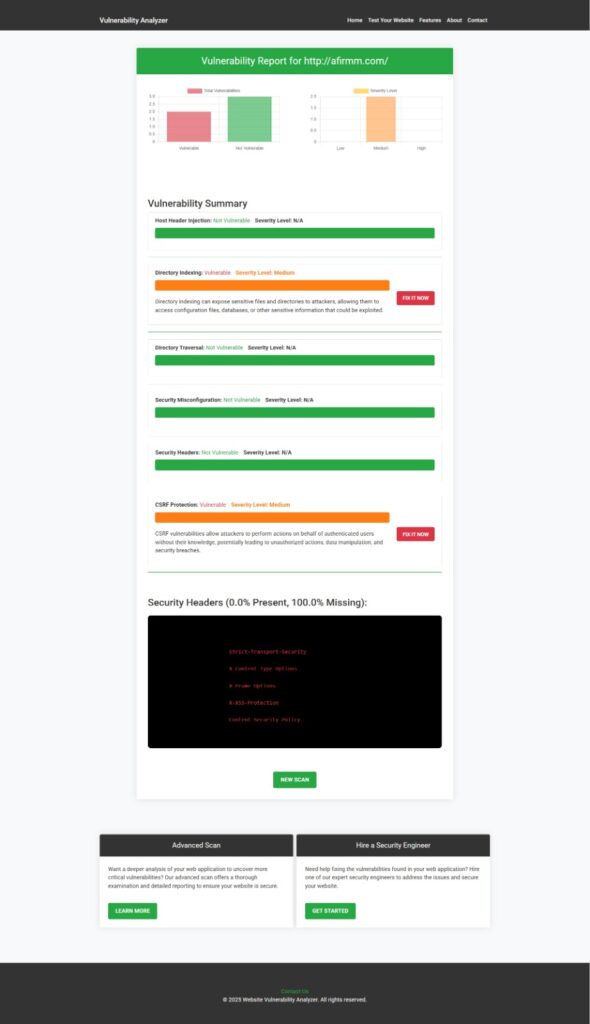SQL injection attack mitigation in WordPress
If you manage a WordPress site, “good enough” security isn’t enough. Attackers still weaponize sloppy queries, unescaped input, and brittle plugins. In this guide, we’ll walk through SQL injection attack mitigation in WordPress step-by-step with practical, copy-paste-ready snippets that you can ship today. We’ll also show where to put screenshots of our free scanner in the body, link out to deeper reads, and share real-world guardrails that go beyond theory.

Why SQL injection still bites WordPress sites
WordPress core is pretty good, but custom code (themes, plugins, one-off admin pages) often bypasses guardrails. That’s where SQL injection in WordPress matters most. Anywhere you interpolate user input into a SQL string, you create a blast radius. Your defense is simple: sanitize → validate → parameterize → least privilege → monitor. Repeat this mantra and you’ll drastically reduce risk.
Quick checklist for SQL injection attack mitigation in WordPress
- Always parameterize with
$wpdb->prepare()and format strings. - Sanitize and validate early (
sanitize_text_field,absint,sanitize_key,wp_unslash). - Prefer
$wpdb->insert(),$wpdb->update(),$wpdb->delete()with$format. - Restrict DB privileges and rotate credentials.
- Add a WAF and rate limiting at the edge.
- Log queries and alert on anomalies.
- Regularly scan for Website Security tests with automated tooling.
Safe reads with $wpdb->prepare() (the non-negotiable)
Bad (vulnerable):
global $wpdb;
$user_id = $_GET['user_id']; // tainted
$sql = "SELECT * FROM {$wpdb->prefix}orders WHERE user_id = $user_id"; // ❌ injection risk
$rows = $wpdb->get_results($sql);Good (parameterized):
global $wpdb;
$user_id = isset($_GET['user_id']) ? absint($_GET['user_id']) : 0;
$sql = $wpdb->prepare(
"SELECT * FROM {$wpdb->prefix}orders WHERE user_id = %d",
$user_id
);
$rows = $wpdb->get_results($sql); // ✅ safeUsing %d, %f, %s format placeholders is the foundation of SQL injection mitigation.
Safe writes with $wpdb->insert()/update() and $format
global $wpdb;
$table = $wpdb->prefix . 'contacts';
$name = sanitize_text_field( wp_unslash( $_POST['name'] ?? '' ) );
$email = sanitize_email( wp_unslash( $_POST['email'] ?? '' ) );
$wpdb->insert(
$table,
[ 'name' => $name, 'email' => $email, 'created_at' => current_time('mysql') ],
[ '%s', '%s', '%s' ]
); // ✅ safe write$wpdb->update(
$table,
[ 'email' => $email ],
[ 'id' => absint($_POST['id'] ?? 0) ],
[ '%s' ],
[ '%d' ]
); // ✅ safe updateThis pattern is central to SQL injection mitigation in WordPress because it enforces parameter binding and type safety.
Validating and sanitizing early (defence-in-depth)
$search = isset($_GET['q']) ? sanitize_text_field( wp_unslash( $_GET['q'] ) ) : '';
$page = isset($_GET['page']) ? max(1, absint($_GET['page'])) : 1;
$sort = isset($_GET['sort']) ? sanitize_key($_GET['sort']) : 'date';
$allowed_sorts = [ 'date', 'price', 'name' ];
if ( ! in_array( $sort, $allowed_sorts, true ) ) {
$sort = 'date';
}Even with sanitization, you still parameterize. That’s how SQL injection mitigation stays robust against edge cases.
Our Website Vulnerability Scanner tool screenshot

We recommend running our free check before and after applying the steps below. It’s a quick win against SQL injection attacks in WordPress.
Avoid string concatenation even with esc_sql()
esc_sql() is not a replacement for prepared statements. Use it only for identifiers (like dynamic table names) you’ve validated:
global $wpdb;
$raw_table = sanitize_key( $_GET['table'] ?? 'orders' );
$table = esc_sql( $wpdb->prefix . $raw_table );
$sql = $wpdb->prepare("SELECT COUNT(*) FROM {$table} WHERE status = %s", 'paid');
$count = (int) $wpdb->get_var($sql);WP_Query and meta queries (don’t roll your own SQL)
$args = [
'post_type' => 'product',
'meta_query' => [
[
'key' => 'sku',
'value' => sanitize_text_field( $_GET['sku'] ?? '' ),
'compare' => '='
]
],
'paged' => max(1, absint($_GET['paged'] ?? 1)),
];
$query = new WP_Query($args); // ✅ lets WP handle safetySecure custom REST endpoints (route params + prepare)
add_action('rest_api_init', function () {
register_rest_route('shop/v1', '/orders/(?P<user_id>\d+)', [
'methods' => 'GET',
'callback' => 'shop_get_orders',
'permission_callback' => function() {
return current_user_can('read'); // adjust as needed
}
]);
});
function shop_get_orders($request) {
global $wpdb;
$user_id = absint( $request->get_param('user_id') );
$sql = $wpdb->prepare(
"SELECT id, total, created_at FROM {$wpdb->prefix}orders WHERE user_id = %d ORDER BY id DESC LIMIT 50",
$user_id
);
return rest_ensure_response( $wpdb->get_results($sql) );
}Strong routes + bound params = cleaner SQL injection mitigation in WordPress for headless or SPA setups.
Admin pages: nonces + capability checks + prepared queries
// In your form:
wp_nonce_field( 'save_coupon', 'save_coupon_nonce' );
// In your handler:
if ( ! current_user_can('manage_options') ) {
wp_die('Unauthorized');
}
check_admin_referer( 'save_coupon', 'save_coupon_nonce' );
$code = sanitize_text_field( $_POST['code'] ?? '' );
$limit = absint( $_POST['limit'] ?? 0 );
global $wpdb;
$wpdb->insert(
$wpdb->prefix . 'coupons',
[ 'code' => $code, 'limit' => $limit ],
[ '%s', '%d' ]
);Pairing nonces and capabilities with parameterized queries is real-world SQL injection in WordPress.
Minimal plugin scaffold that enforces safe queries
/**
* Plugin Name: Safe Orders
*/
defined('ABSPATH') || exit;
add_shortcode('safe_orders_list', function($atts){
global $wpdb;
$user_id = get_current_user_id();
$limit = isset($atts['limit']) ? min(50, absint($atts['limit'])) : 10;
$sql = $wpdb->prepare(
"SELECT id, total FROM {$wpdb->prefix}orders WHERE user_id = %d ORDER BY id DESC LIMIT %d",
$user_id, $limit
);
$rows = $wpdb->get_results($sql);
ob_start();
echo '<ul class="orders">';
foreach ($rows as $r) {
echo '<li>#' . (int)$r->id . ' — ' . esc_html( $r->total ) . '</li>';
}
echo '</ul>';
return ob_get_clean();
});PDO example (for external scripts that touch the same DB)
$dsn = 'mysql:host=' . DB_HOST . ';dbname=' . DB_NAME . ';charset=utf8mb4';
$pdo = new PDO($dsn, DB_USER, DB_PASSWORD, [
PDO::ATTR_ERRMODE => PDO::ERRMODE_EXCEPTION,
PDO::ATTR_DEFAULT_FETCH_MODE => PDO::FETCH_ASSOC,
]);
$stmt = $pdo->prepare('SELECT * FROM wp_orders WHERE user_id = :uid');
$stmt->execute([ ':uid' => (int) $_GET['user_id'] ]);
$data = $stmt->fetchAll();Database hardening (least privilege, rotated creds)
MySQL user with limited rights:
CREATE USER 'wp_app'@'%' IDENTIFIED BY 'REDACTED-STRONG-PASSWORD';
GRANT SELECT, INSERT, UPDATE, DELETE ON `wp_prod`.* TO 'wp_app'@'%';
FLUSH PRIVILEGES;Update wp-config.php:
define('DB_USER', 'wp_app');
define('DB_PASSWORD', 'REDACTED-STRONG-PASSWORD');Reducing privileges shrinks the blast radius—an underrated piece of SQL injection mitigation in WordPress.
Edge defenses: WAF patterns and rate limiting
Even perfect code benefits from a WAF. Block obvious payloads and throttle noisy clients. Treat it as a belt-and-suspenders approach to SQL injection mitigation in WordPress.
Nginx rate-limit example:
limit_req_zone $binary_remote_addr zone=req_limit:10m rate=5r/s;
server {
location / {
limit_req zone=req_limit burst=20 nodelay;
proxy_pass http://phpfpm;
}
}Logging suspicious queries for forensics
add_filter('query', function($query){
if ( preg_match('/(UNION\s+SELECT|SLEEP\(|--|\bOR\b\s+1=1)/i', $query) ) {
error_log('[SQLi-guard] Suspicious query: ' . $query);
}
return $query;
});Logging complements SQL injection attack mitigation in WordPress with visibility and post-incident clues.
Sample assessment report to check Website Vulnerability

Showing a before/after report keeps teams accountable and reinforces SQL injection mitigation with measurable improvement.
Continuous testing: curl payloads + WP-CLI
Quick smoke test (expect a 400 or sanitized response):
curl -i "https://example.com/?user_id=1%20UNION%20SELECT%201,2,3"WP-CLI to run a probe task:
wp eval '
global $wpdb;
$q = $wpdb->prepare("SELECT COUNT(*) FROM {$wpdb->prefix}posts WHERE post_status=%s", "publish");
echo (int) $wpdb->get_var($q);
'Automate these checks in CI/CD to keep SQL injection attack mitigation in WordPress from regressing over time.
Helpful deep dives & related posts
- CSP pitfalls: CSP bypass in React JS
- Input handling: Top 7 CRLF injection in Laravel
- WordPress developer: XSS Prevention in WordPress
- Logic flaws: Business logic vulnerabilities in Laravel
- Sector guide: Healthcare software penetration testing
These complement SQL injection attack mitigation in WordPress by rounding out your app-sec toolkit.
Our services (tailored to your stack)
Managed IT Services
From patch pipelines to monitored backups, our Managed IT Services reduce operational risk and support SQL injection attack mitigation in WordPress at scale.
AI Application Cybersecurity
Shipping LLM features? Our AI Application Cybersecurity offering stress-tests prompts, guards data flows, and incorporates SQL injection attack mitigation in WordPress patterns into AI-driven plugins.
Offer Cybersecurity Service to Your Client
Agencies: white-label our team with Offer cybersecurity service to your client. We audit custom code and embed SQL injection attack mitigation in WordPress practices directly in your delivery.
Wrap-up
Security is a habit. Sanitize early, validate strictly, parameterize always, limit privileges, and monitor continuously. If you follow these patterns, SQL injection mitigation becomes second nature—and your attack surface shrinks dramatically.
Next step: Run a baseline scan with our free tool here → https://free.pentesttesting.com/, fix anything it flags, and rescan. That tight feedback loop keeps SQL injection mitigation in WordPress practical and measurable.
🔐 Frequently Asked Questions (FAQs)
Find answers to commonly asked questions about S.

